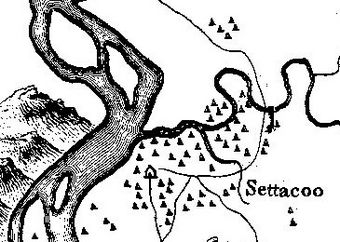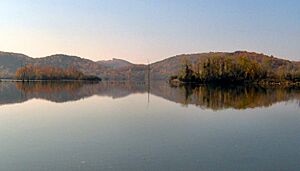Citico (Cherokee town) facts for kids
Quick facts for kids |
|
|
Citico
|
|

Citico ("Settacoo") on Henry Timberlake's 1762 "Draught of the Cherokee Country"
|
|
| Location | Monroe County, Tennessee |
|---|---|
| Nearest city | Vonore |
| Built | 1000–1500 CE |
| NRHP reference No. | 78002614 |
| Added to NRHP | 1978 |
Citico (also called "Settaco" or "Sitiku") was a very old and important Native American site. It is located in Monroe County, Tennessee. The famous Cherokee village of Citico was the biggest of the Overhill towns. About 1,000 people lived there in the mid-1700s.
Before the Cherokee, a different village was here. It was part of the Mississippian culture. This earlier village might have been "Satapo." The Spanish explorer Juan Pardo visited Satapo in 1567.
Today, the Citico site is underwater. It is covered by Tellico Lake. This lake was formed when the Tellico Dam was built in 1979. The dam holds back the Little Tennessee River. A town called Citico Beach is now along the lake's shore. The Tennessee Valley Authority helps manage the lake.
Contents
Where Was Citico Located?
Tellico Lake covers the last 33 miles (53 km) of the Little Tennessee River. This river flows from the mountains. It goes through parts of Blount, Monroe, and Loudon counties. Then it joins the Tennessee River near Lenoir City.
The Citico site was on the southwest bank of the Little Tennessee River. It was right where Citico Creek flows into the river. This area is where the Great Smoky Mountains and Unicoi Mountains meet the Ridge-and-Valley Appalachians.
You can find Citico Beach on Highway 455. It is about 14 miles (23 km) south of Vonore. You can also see where the Citico site was from the Harrison Branch boat ramp. This ramp is off U.S. Route 129.
A Look Back: Citico's History
The Ancient Village of Satapo
On October 16, 1567, a Spanish group led by Juan Pardo arrived at a village. It was called "Satapo." They were traveling to Coosa, a powerful chiefdom in what is now northern Georgia.
A researcher named Charles Hudson studied this in the 1980s. He believes Satapo was at the Citico site. He also thinks the names "Satapo" and "Citico" are connected.
Hudson believes the Cherokee kept the name "Satapo" when they moved in. But the Cherokee language does not have a "p" sound. So, the "p" in "Satapo" changed to a "k" sound. This is how it became "Sitiku" or "Citico."
Life in the Cherokee Village
The Cherokee people had a special belief about a cliff near Citico. They thought two giant hawks, called "Tlanuwas," once lived there. These hawks scared the people in the valley. A high priest finally took their eggs. He dropped them into the water. There, a mythical creature called the Uktena ate them.
Citico was a busy Cherokee village when English explorers arrived in the early 1700s. In 1725, Citico's leader met with Colonel George Chicken. They formed an alliance against the Creeks. Citico also appeared on George Hunter's 1730 map of the Cherokee lands.
Captain Henry Timberlake visited the Overhill towns in 1761–1762. He was on a peace mission. He reported that Citico had 204 warriors. This was the most of any Overhill town. Cheulah, Citico's leader, welcomed Timberlake with a dance. About 400 townspeople joined in. Timberlake later smoked many peace pipes at the Citico townhouse. He said he "could not stir for several hours" afterward.
The Decline of Citico
The Overhill Cherokee often had problems with European settlers. During the American Revolutionary War, the Cherokee sided with the British. In 1776, American forces attacked the Overhill towns. Colonel William Christian burned five towns, including Citico.
The people of Citico had already left the town. They followed War Chief Dragging Canoe to a new location. They built a new town with the same name near what is now Chattanooga.
Later, in 1782, a meeting happened at the original Citico. Militia commander John Sevier and Cherokee Chief Hanging Maw agreed to a truce. But two years later, a fight broke out. Major James Hubbard killed Untoola, a Cherokee leader from Citico.
In the late 1780s, a group of scouts was at the old Citico site. They were gathering apples. A group of Cherokees ambushed them. Sixteen of the scouts were killed. Captain Nathaniel Evans arrived with more soldiers. They joined John Sevier's larger force. They then chased the Cherokee who were responsible.
What We Learned from Archaeology
Scientists found very old tools at Citico. These included tools from the Paleo-Indian and Archaic periods (8000–1000 BCE). A large Woodland period (1000 BCE–1000 CE) site was also nearby. But Citico likely became very important around the 1500s. At this time, Citico probably became the main Mississippian village in the Little Tennessee Valley. It took over from a place called Toqua.
In the 1880s, a survey found eight mounds at Citico. One was a large "temple" mound. The others were smaller. The temple mound held at least 91 burials. A small dig found many artifacts. These included items from the Woodland, Mississippian, and Cherokee periods. They found shell necklaces and knife blades. They also found a Cherokee burial with a musket, knife, pipe, and glass beads.
Before Tellico Lake flooded the area, the University of Tennessee studied Citico. They dug there in the late 1960s and 1970s. They found outlines of 11 houses. They also found 55 burials and over 30,000 pieces of pottery.
The houses included two pairs of summer and winter homes. These were typical Cherokee dwellings. They also found Spanish items like Clarksdale bells. This helped prove that Citico was indeed the Satapo visited by Juan Pardo.
Scientists also studied animal bones from the Cherokee period. They found that people first ate a lot of deer and bear. Later, they started eating more farm animals like hogs and chickens. This showed they began using European farming methods.
Images for kids




